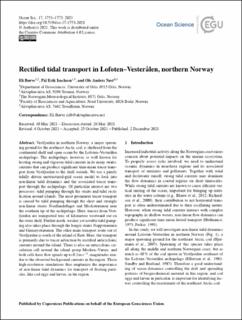| dc.contributor.author | Børve, Eli | |
| dc.contributor.author | Isachsen, Pål Erik | |
| dc.contributor.author | Nøst, Ole Anders | |
| dc.date.accessioned | 2022-02-11T13:46:37Z | |
| dc.date.available | 2022-02-11T13:46:37Z | |
| dc.date.created | 2021-12-03T16:10:17Z | |
| dc.date.issued | 2021 | |
| dc.identifier.citation | Børve, E., Isachsen, P. E. & Nøst, O. A. (2021). Rectified tidal transport in Lofoten–Vesterålen, northern Norway. Ocean Science, 17(6), 1753-1773. doi: | en_US |
| dc.identifier.issn | 1812-0792 | |
| dc.identifier.uri | https://hdl.handle.net/11250/2978520 | |
| dc.description.abstract | Vestfjorden in northern Norway, a major spawning ground for the northeast Arctic cod, is sheltered from the continental shelf and open ocean by the Lofoten–Vesterålen archipelago. The archipelago, however, is well known for hosting strong and vigorous tidal currents in its many straits, currents that can produce significant time-mean tracer transport from Vestfjorden to the shelf outside. We use a purely tidally driven unstructured-grid ocean model to look into non-linear tidal dynamics and the associated tracer transport through the archipelago. Of particular interest are two processes: tidal pumping through the straits and tidal rectification around islands. The most prominent tracer transport is caused by tidal pumping through the short and strongly non-linear straits Nordlandsflaget and Moskstraumen near the southern tip of the archipelago. Here, tracers from Vestfjorden are transported tens of kilometers westward out on the outer shelf. Further north, weaker yet notable tidal pumping also takes place through the longer straits Nappstraumen and Gimsøystraumen. The other main transport route out of Vestfjorden is south of the island of Røst. Here, the transport is primarily due to tracer advection by rectified anticyclonic currents around the island. There is also an anticyclonic circulation cell around the island group Mosken–Værøy, and both cells have flow speeds up to 0.2 m s−1, magnitudes similar to the observed background currents in the region. These high-resolution simulations thus emphasize the importance of non-linear tidal dynamics for transport of floating particles, like cod eggs and larvae, in the region. | en_US |
| dc.language.iso | eng | en_US |
| dc.publisher | Copernicus Publications | en_US |
| dc.rights | Navngivelse 4.0 Internasjonal | * |
| dc.rights.uri | http://creativecommons.org/licenses/by/4.0/deed.no | * |
| dc.title | Rectified tidal transport in Lofoten–Vesterålen, northern Norway | en_US |
| dc.type | Peer reviewed | en_US |
| dc.type | Journal article | en_US |
| dc.description.version | publishedVersion | en_US |
| dc.rights.holder | © 2021 The Author(s) | en_US |
| dc.subject.nsi | VDP::Matematikk og Naturvitenskap: 400::Geofag: 450::Oseanografi: 452 | en_US |
| dc.source.pagenumber | 1753-1773 | en_US |
| dc.source.volume | 17 | en_US |
| dc.source.journal | Ocean Science | en_US |
| dc.source.issue | 6 | en_US |
| dc.identifier.doi | 10.5194/os-17-1753-2021 | |
| dc.identifier.cristin | 1964596 | |
| dc.relation.project | VISTA: 6168 | en_US |
| dc.relation.project | The Norwegian Meteorological Institute: 181090 | en_US |

